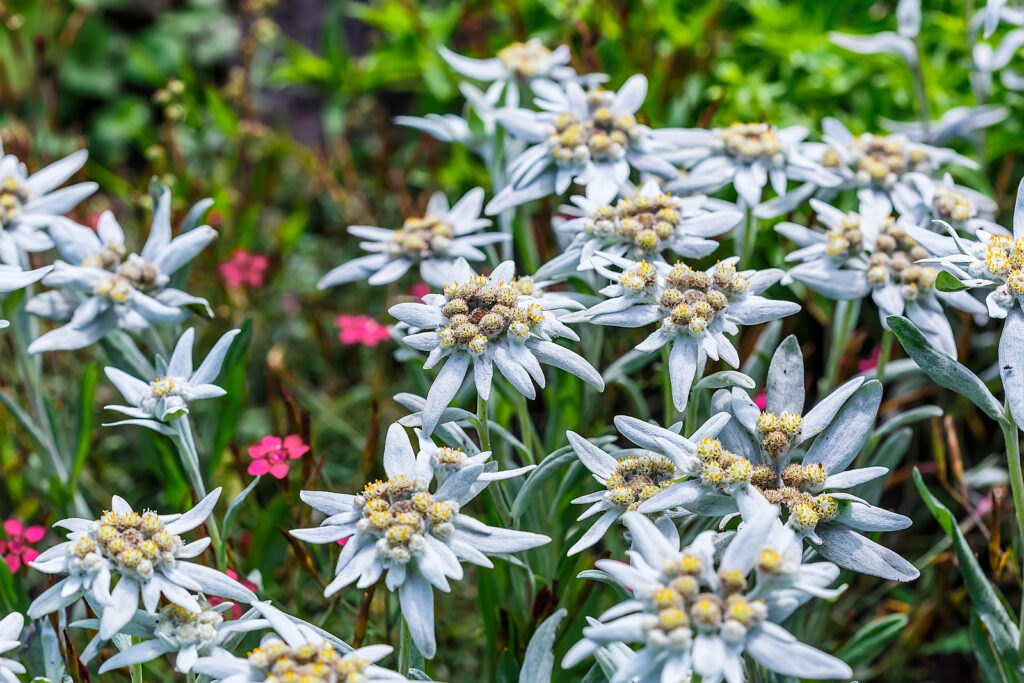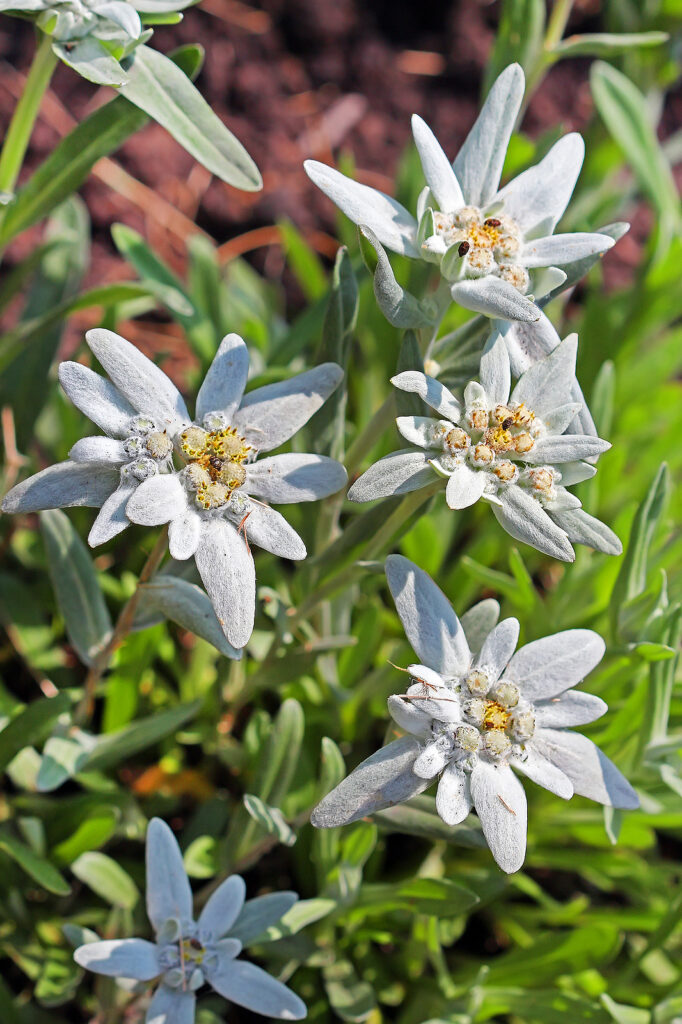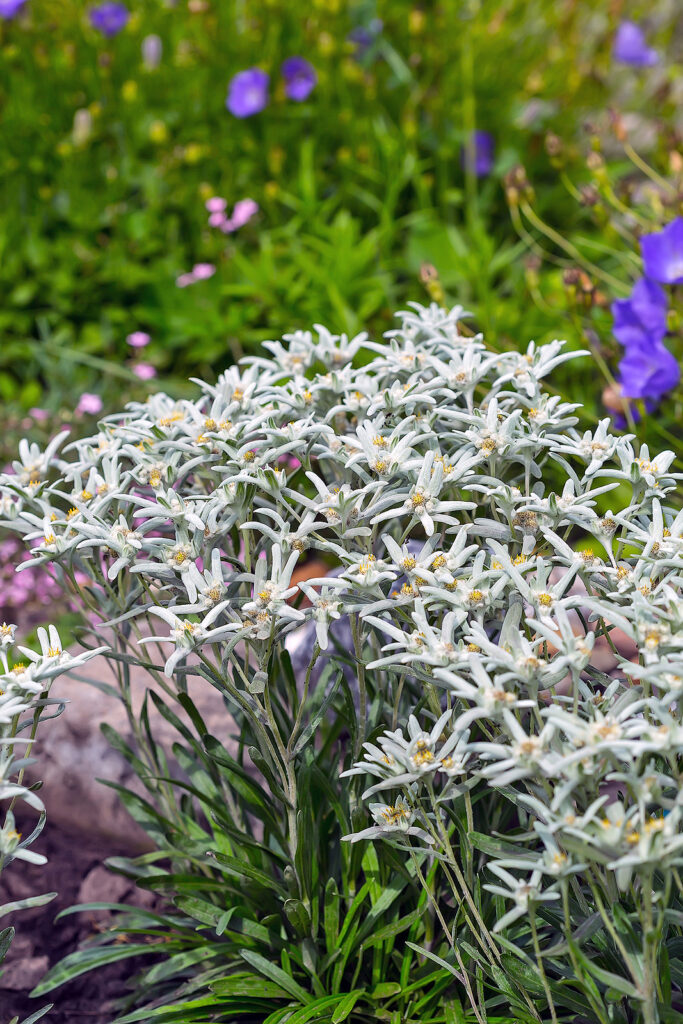Leontopodium, commonly known as edelweiss, is a low-growing alpine plant native to mountain regions of Europe and Asia. These plants are known for their distinctive white, star-shaped flowers that have a woolly or fuzzy appearance.
Leontopodium is a delicate perennial plant that usully survives just a year or two. Leontopodum belong to the sunflower family, Asteraceae. Its leaves are covered in a dense layer of woolly hairs which helps protect the plant from cold temperatures, cold winds, and strong UV radiation at high altitudes.
Leontopodium is often associated with mountainous regions and traditional folklore. It has been used in various herbal remedies and cosmetics due to its purported medicinal properties. The plants are also popular in gardens for their unique appearance and ability to thrive in harsh environments.

Get to know Leontopodium
- Plant type: Perennial
- Growing zones and range: Zones 4-9
- Hardiness: Winter hardy
- Height and width: 12 inches tall and wide
- Foliage: Wooly white stem with slender leaves that radiate below each flower head
- Flowers: White, star-shaped flowers
- Bloom time: Early summer
- Uses: Rock garden, alpine gardens, partial shade garden or border
- Common name: Edelweiss
- Botanical name: Leontopodium alpinum
- Family name: Asteraceae
- Origin: Alpine regions of Europe and Asia
Where to plant Leontopodium
- Leontopodium prefers full sun to partial shade. Grow Leontopodium in a sunny location where they will receive at least 6 hours of sunlight per day.
- Leontopodium plants prefer cool, alpine-like conditions with well-draining soil and good air circulation. They do best in USDA hardiness zones 4 to 9. 2.
- Leontopodium plants thrive in gritty, well-draining soil that is slightly acidic. Amend heavy or clay soil with sand or perlite to improve drainage.
- Make sure the planting area has good air circulation to prevent diseases.
When to plant Leontopodium
- Leontopodium can be grown from seeds, division, or nursery-grown plants. Plant them in the spring after the last frost has passed.

Planting and spacing Leontopodium
- Starting from seed, sow Leontopodium seeds in a seed tray filled with a well-draining soil mix. Keep the soil evenly moist until the seeds germinate. Transplant the seedlings into individual pots once they have a few sets of true leaves.
- To transplant Leontopodium into the garden, dig a hole that is slightly larger than the root ball of the plant and gently spread out the roots before covering them with soil. Water thoroughly after planting.
How to water and feed Leontopodium
- Leontopodium prefers moderate watering. Water the plant when the soil feels dry to the touch, but avoid overwatering as it can lead to root rot.
- Leontopodium is relatively drought-tolerant, but it still requires regular watering, especially during hot and dry periods. Water the plant deeply to encourage deep root growth.
- Leontopodium does not require heavy fertilization. Feed Leontopodium with a balanced fertilizer once a month during the growing season to promote healthy growth. You can apply a balanced, slow-release fertilizer in the spring to help promote healthy growth.
- Avoid using too much nitrogen, as it can promote excessive foliage growth at the expense of flowers.
Leontopodium care
- Leontopodium plants are relatively low-maintenance and require minimal care. Deadhead spent flowers to encourage new growth and prevent self-seeding.
- Prune Leontopodium after it has finished flowering to encourage new growth and maintain a compact shape.
- Cut back the plant in the fall to remove dead or damaged growth. This will also help the plant maintain its shape and promote healthy growth the following season.
- Winter care: Leontopodium is cold-hardy but may benefit from some winter protection in harsh climates. Mulch the base of the plant to protect the roots from freezing temperatures. Mulch around the base of the plant or covering it with a layer of straw.

Leontopodium pests and diseases
- Leontopodium plants are generally pest and disease-resistant, but they can be susceptible to root rot if they are grown in soil that is too wet. Watch for signs of rotting and adjust your watering practices accordingly.
Leontopodium propagation
- Leontopodium can be grown from seed or propagated from cuttings.
- Propagate Leontopodium from cuttings in early summer. Take 4 to 6 inch cuttings from the plant and plant them in a well-draining soil mix. Keep the soil moist and place the cuttings in a warm, sunny location to encourage root development.
- Leontopodium seeds should be started indoors in the early spring and transplant outdoors after the last frost.



